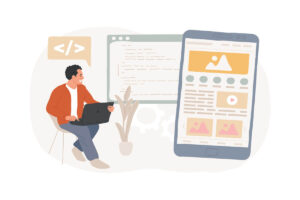Understanding the dynamism of the mobile app development landscape in 2024 is crucial for developers aiming to stay ahead of the curve. To simplify the selection process for developers, our detailed analysis focuses on versatility, user experience, integration capabilities, supported languages, and cost-efficiency. This guide aims to unveil the top 5 mobile app development software that have proved their mettle in these criteria.
Criteria for Evaluation
Before diving into our top picks, let’s reiterate the evaluated criteria that form the backbone of our analysis:
- Versatility: Can the software be used to develop apps for multiple platforms?
- User Experience: Does the software provide a smooth, intuitive interface?
- Integration Capabilities: How well does it integrate with other tools and systems?
- Supported Languages: What programming languages does the software support?
- Cost-Efficiency: Is it competitively priced for the features it offers?
The Top 5 Mobile App Development Software
Each of these software options brings its unique strengths to the table, catering to a variety of development needs. So, without further ado, let’s take a look at our top picks for 2024:
Xamarin: The Unified Approach
Features and Capabilities
- Single codebase for multiple platforms.
- Robust performance with .NET ecosystem.
- C# language support.
Pros and Cons
Pros
- Significant reduction in development time and costs.
- Strong integration with Microsoft’s ecosystem.
Cons
- Larger app size compared to native apps.
- Requires learning C# and .NET framework.
Ideal Use Case Scenarios
- Businesses that want to reach a broad audience across both iOS and Android with reduced costs.
- Projects that intend to leverage extensive Microsoft services or existing .NET libraries.
React Native: The Best of Both Worlds
Features and Capabilities
- Real native apps using JavaScript and React.
- Live reloading for real-time code updates.
Pros and Cons
Pros
- Shared codebase between iOS and Android.
- Large community and ecosystem.
Cons
- Native modules may be required for advanced functionalities.
- Performance can be slightly less than fully native apps.
Ideal Use Case Scenarios
- Startups and enterprises looking for rapid development and deployment.
- Applications that require a rich user interface with responsive design.
Flutter: The New Contender
Features and Capabilities
- Compilation for mobile, web, and desktop from a single codebase.
- Fast development with hot reload.
- Customizable widgets for unique designs.
Pros and Cons
Pros
- High performance with native compilation.
- Growing ecosystem with design-oriented widgets.
Cons
- Relatively new with fewer resources compared to established frameworks.
- Limited third-party libraries.
Ideal Use Case Scenarios
- Developers aiming for expressive and flexible UI with a focus on animation.
- Projects that value design and want a consistent brand experience across multiple platforms.
Android Studio: The Android Authority
Features and Capabilities
- Official IDE for Android development.
- Gradle-based build system.
- Emulator for all Android devices.
Pros and Cons
Pros
- Comprehensive tooling and plugins.
- Strong support for Android app development.
Cons
- Steeper learning curve for beginners.
- Exclusively for Android development, which means a separate process for iOS.
Ideal Use Case Scenarios
- Developers who are focused on one platform – Android.
- Advanced projects that require full control over platform-specific features and integrations.
Swiftic: The Icon of User-Friendliness
Features and Capabilities
- No-code platform for iOS and Android app development.
- Customizable templates and intuitive design interface.
Pros and Cons
Pros
- Accessible to non-technical users.
- Quick setup and fast app publishing.
Cons
- Limited functionality compared to coding from scratch.
- May not be suitable for complex app requirements.
Ideal Use Case Scenarios
- Small business owners who need a simple, functional app without technical expertise.
- Projects where time-to-market is critical and the app demands are within the capabilities of template-based designs.
Comparison and Recommendations
When considering the landscape of mobile app development software, it becomes apparent that each platform serves a unique niche. For developers who prioritize design and flexibility, Flutter emerges as a robust choice, with its strong UI focus and cross-platform consistency. Though it has fewer third-party libraries compared to established frameworks, its expressive toolkit makes it ideal for projects where animation and design are paramount. On the other hand, Android Studio stands as the go-to for Android-specific development, offering comprehensive tools and plugins for developers seeking to harness the full potential of Android’s capabilities. However, for those who are new to development or require a straightforward functional app with a quick turnaround, Swiftic offers a user-friendly alternative with its no-code approach and customizable templates.
Given these nuances, recommendations depend largely on the project’s goals and the developers’ expertise. For a balanced approach tailored to both Android and iOS without needing extensive third-party libraries, Flutter might be the best option. Android Studio is recommended for projects that require deep integration with Android’s ecosystem and are less concerned with cross-platform availability. Swiftic is well-suited for individuals or small businesses needing a simple app with minimal investment in time and technical skill.
Future Outlook
As we look towards the future, mobile app development software is poised for further evolution, influenced by the rising demand for more sophisticated and integrated app experiences.
A staggering statistic reveals that Mobile apps are projected to generate more than 613 billion U.S. dollars in revenues in 2025 according to Statista.
This potential for growth could lead to an increase in demand for advanced features within no-code platforms and further enhancement of cross-platform development tools. We might also anticipate a rise in AI-driven development assistance within these platforms, making it easier to create apps that are more personalized and intelligent.
Conclusion
In summary, the choice of mobile app development software should be aligned with the project’s unique needs, timelines, and the technical ability of the developer or team. From the animation-rich Flutter to the Android-centric Android Studio and the no-code simplicity of Swiftic—each offers distinct advantages that cater to different scenarios. Looking ahead, one can expect these platforms to adapt and evolve, incorporating cutting-edge technologies that will shape the future of app development. Contact us today to learn more about which mobile app development software is right for your project. So, it’s essential to stay updated with the latest trends and developments in this rapidly evolving industry.











+ There are no comments
Add yours